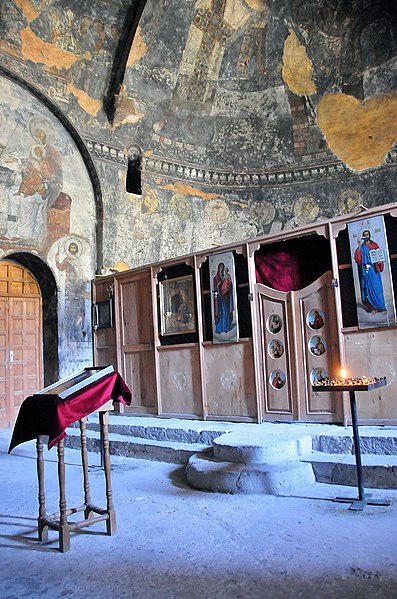Vardzia is a cave monastery site in southern Georgia, excavated from the slopes of the Erusheti Mountain on the left bank of the Kura River, thirty kilometres from Aspindza. The main period of construction was the second half of the twelfth century. The caves stretch along the cliff for some five hundred meters and in up to nineteen tiers. The monastery was an important cultural center, a place of significant literary and artistic work.
Five monks still live in this mountain. Every morning at seven they ring the bell in the high arch.
Rat'i Surameli, Duke of Javakheti and Kartli, wearing a sharbush and a front-opening qaba with tiraz, slightly before 1186, Vardzia, southern Georgia, Inv. No. 5246-262.
Tamar in the Church of the Dormition, with a model of the church; an aetiological myth has the young Tamar, when out hunting with Giorgi, lost in the caves; when called for, she replied "I am here, uncle" (Georgian: აქ ვარ ძია) "ak var dzia", giving the site its name
View to the apse and iconostasis or screen decorated with icons that separates the nave from the sanctuary
Tamar the Great reigned as the Queen of Georgia from 1184 to 1213, presiding over the apex of the Georgian Golden Age. A member of the Bagrationi dynasty, her position as the first woman to rule Georgia in her own right was emphasized by the title mepe ("king"), afforded to Tamar in the medieval Georgian sources.
Fresco at the church of Dormition in Vardzia
Tamar (left) and George III (right). The earliest surviving portrait of Tamar from the church of the Dormition at Vardzia, c. 1184–1186.
Tamar as depicted on a 13th-century mural from the Kintsvisi monastery.
The Iviron monastery on Mount Athos, a major center of Christian culture favored by the Georgian crown.








